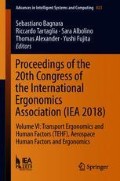Abstract
Signal passed at danger events (SPADs) impact safety-risk on rail networks, despite the introduction of novel technologies aimed at addressing their cause and effect. Much of the rail safety literature has had a tendency to focus on activities within the cab, placing a spotlight on “errors” within the train driving role. However, a train is not propelled by a single person—is it is propelled by a tightly-coupled team where driving and train controlling activities are distributed but must work in concert. This study set out to understand how controllers perceive the controller-driver dynamic, and how these perspectives impact upon SPAD-risk. Interviews were conducted with 35 train controllers from 6 rail organisations across Australia and New Zealand. Data were collected using the SITT forward scenario simulation method and analysed using conventional content analysis. Eleven different perspectives were identified, ranging in type and varying by frequency, each with implications for the strength of the coupling in distributed cognition between the controller and driver roles and with implications for SPAD-risk. How these perspectives may influence controller-driver dynamics are illustrated using sample scenarios from the data. The findings emphasise key dimensions of the teaming factors in the movement of trains and illustrate how the underlying values and philosophies in different train controlling cultures influence safety. Findings are discussed in the context of obtaining a holistic and more informed model of train driving.
Access this chapter
Tax calculation will be finalised at checkout
Purchases are for personal use only
Notes
- 1.
The term “SPAD” is used to encompass any scenario where a train has encroached into an area it has no authority and can therefore include non-signalled environments. SPADs are most common in setting which use traditional driving/multi-aspect signalling practices but can also happen in advanced rail networks with sophisticated signalling systems.
References
Naweed A, Trigg J, Cloete S, Allan P, Bentley T (in press) Throwing good money after SPAD? Exploring the cost of signal passed at danger (SPAD) incidents to Australasian rail organisations. Saf Sci. https://doi.org/10.1016/j.ssci.2018.05.018
Singh H, Hanna J (2015) India train derailment: 30 killed, 50 injured, 20 March
ATSB (2012) Australian Rail Safety Occurrence Data, 1 July 2002 to 30 June 2012. Canberra, ACT: ATSB, 2012 Contract No.: RR-2012-010
Indep Trans Saf Regulator (2011) Transport safety bulletin: Focus on SPAD
Naweed A (2013) Psychological factors for driver distraction and inattention in the AU and NZ rail industry. Acc Anal Prev 60:193–204
Naweed A, Rainbird S, Chapman J (2015) Investigating the formal countermeasures and informal strategies used to mitigate SPAD risk in train driving. Ergonomics 58(6):883–896
Naweed A, Rainbird S, Dance C (2015) Are you fit to continue? Approaching rail systems thinking at the cusp of safety and the apex of performance. Saf Sci 76:101–110
Rainbird S, Naweed A (2016) Signs of respect: embodying the train driver–signal relationship to avoid rail disasters. Appl Mobilities 2(1):50–66
Woods D, Hollnagel E (2006) Joint cognitive systems: patterns in cognitive systems engineering. Taylor & Francis, Boca Raton
Curry LA, Nembhard IM, Bradley EH (2009) Qualitative and mixed methods provide unique contributions to outcomes research. Circulation 119(10):1442–1452
Ferroff CV, Marvin TJ, Bates PR, Murry PS (2012) A case for social constructionism in aviation safety and performance research. Aeronutica 2(1):1–12
Naweed A, Balakrishnan G (2014) Understanding the visual skills and strategies of train drivers in the urban rail environment. Work 47(3):339–352
Klein G, Calderwood R, Macgregor DG (1989) Critical decision method for eliciting knowledge. IIEE Trans Syst Manuf Cybern 19(3):462–472
Monk A, Howard S (1998) Rich picture: a tool for reasoning about work context. Interactions 2(5):21–30
Naweed A, Balakrishnan G, Bearman C, Dorrian J, Dawson D (2012) Scaling generative scaffolds towards train driving expertise. In: Anderson M (ed) Contemporary ergonomics and human factors 2012: proceedings of the international conference on ergonomics & human factors 2012. CRC Press, Blackpool, p 235
Filtness AJ, Naweed A (2017) Causes, consequences and countermeasures to driver fatigue in the rail industry: The train driver perspective. Appl Ergon 60:12–21
O’Keeffe VJ, Tuckey MR, Naweed A (2015) Whose safety? flexible risk assessment boundaries balance nurse safety with patient care. Saf Sci 76:111–120
Hsieh H-F, Shannon SE (2005) Three approaches to qualitative content analysis. Qual Health Res 15(9):1277–1288
Viegas FB, Wattenberg M, Feinberg J (2009) Participatory visualization with wordle. IEEE Trans Vis Comput Graph 15(6)
Author information
Authors and Affiliations
Corresponding author
Editor information
Editors and Affiliations
Rights and permissions
Copyright information
© 2019 Springer Nature Switzerland AG
About this paper
Cite this paper
Naweed, A. (2019). A Team Drives the Train: Human Factors in Train Controller Perspectives of the Controller-Driver Dynamic. In: Bagnara, S., Tartaglia, R., Albolino, S., Alexander, T., Fujita, Y. (eds) Proceedings of the 20th Congress of the International Ergonomics Association (IEA 2018). IEA 2018. Advances in Intelligent Systems and Computing, vol 823. Springer, Cham. https://doi.org/10.1007/978-3-319-96074-6_29
Download citation
DOI: https://doi.org/10.1007/978-3-319-96074-6_29
Published:
Publisher Name: Springer, Cham
Print ISBN: 978-3-319-96073-9
Online ISBN: 978-3-319-96074-6
eBook Packages: Intelligent Technologies and RoboticsIntelligent Technologies and Robotics (R0)

